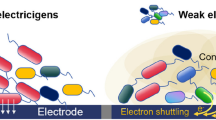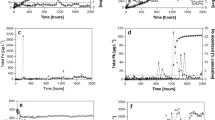Abstract
Anaerobic diesel fuel Arctic (DFA) degradation has already been demonstrated in Antarctic soils. However, studies comparing the distribution of anaerobic bacterial groups and of anaerobic hydrocarbon-degrading bacteria in Antarctic soils containing different concentrations of DFA are scarce. In this study, functional genes were used to study the diversity and distribution of anaerobic hydrocarbon-degrading bacteria (bamA, assA, and bssA) and of sulfate-reducing bacteria (SRB—apsR) in highly, intermediate, and non-DFA-contaminated soils collected during the summers of 2009, 2010, and 2011 from King George Island, Antarctica. Signatures of bamA genes were detected in all soils analyzed, whereas bssA and assA were found in only 4 of 10 soils. The concentration of DFA was the main factor influencing the distribution of bamA-containing bacteria and of SRB in the analyzed soils, as shown by PCR-DGGE results. bamA sequences related to genes previously described in Desulfuromonas, Lautropia, Magnetospirillum, Sulfuritalea, Rhodovolum, Rhodomicrobium, Azoarcus, Geobacter, Ramlibacter, and Gemmatimonas genera were dominant in King George Island soils. Although DFA modulated the distribution of bamA-hosting bacteria, DFA concentration was not related to bamA abundance in the soils studied here. This result suggests that King George Island soils show functional redundancy for aromatic hydrocarbon degradation. The results obtained in this study support the hypothesis that specialized anaerobic hydrocarbon-degrading bacteria have been selected by hydrocarbon concentrations present in King George Island soils.




Similar content being viewed by others
References
Filler DM, Kennicutt MC, Snape I, Sweet ST, Klein AG (2015) Arctic and Antarctic spills. In: Fingas M (ed) Handbook of oil spill science and technology. Wiley, New Jersey
McWatters RS, Wilkins D, Spedding T, Hince G, Raymond B, Lagerewskij G, Terry D, Wise L, Snape I (2016) On site remediation of a fuel spill and soil reuse in Antarctica. Sci. Total Environ. 571:963–973
Jesus HE, Peixoto RS, Cury JC, van Elsas JD, Rosado AS (2015) Evaluation of soil bioremediation techniques in an aged diesel spill at the Antarctic Peninsula. Appl. Microbiol. Biotechnol. 99(24):10815–10827
Pini F, Grossi C, Nereo S, Michaud L, Giudice AL, Bruni V, Baldi F, Fani R (2007) Molecular and physiological characterisation of psychrotrophic hydrocarbon-degrading bacteria isolated from Terra Nova Bay (Antarctica). Eur. J. Soil Biol. 43:368–379
Akbari A, Ghoshal S (2015) Effects of diurnal temperature variation on microbial community and petroleum hydrocarbon biodegradation in contaminated soils from a sub-Arctic site. Environ. Microbiol. 17(12):4916–4928
Muangchinda C, Chavanich S, Viyakarn V, Watanabe K, Imura S, Vangnai AS, Pinyakong O (2015) Abundance and diversity of functional genes involved in the degradation of aromatic hydrocarbons in Antarctic soils and sediments around Syowa Station. Environ. Sci. Pollut. Res. Int. 22(6):4725–4735
Powell S, Bowman JP, Ferguson SH, Snape I (2010) The importance of soil characteristics to the structure of alkane-degrading bacterial communities on sub-Antarctic Macquarie Island. Soil Biol. Biochem. 42:2012–2021
Guibert LM, Loviso CL, Marcos MS, Commendatore MG, Dionisi HM, Lozada M (2012) Alkane biodegradation genes from chronically polluted subantarctic coastal sediments and their shifts in response to oil exposure. Microb. Ecol. 64:605–616
Jurelevicius D, Alvarez VM, Peixoto R, Rosado AS, Seldin L (2013) The use of a combination of alkB primers to better characterize the distribution of alkane-degrading bacteria. PLoS One 8(6):e66565. doi:10.1371/journal.pone.0066565
Guibert LM, Loviso CL, Borglin S, Jansson JK, Dionisi HM, Lozada M (2016) Diverse bacterial groups contribute to the alkane degradation potential of chronically polluted subantarctic coastal sediments. Microb. Ecol. 71:100. doi:10.1007/s00248-015-0698-0
Flocco CG, Gomes NC, Maccormack W, Smalla K (2009) Occurrence and diversity of naphthalene dioxygenase genes in soil microbial communities from the Maritime Antarctic. Environ. Microbiol. 11:700–714
Jurelevicius D, Alvarez VM, Peixoto R, Rosado AS, Seldin L (2012) Bacterial polycyclic aromatic hydrocarbon ring-hydroxylating dioxygenases (PAH-RHD) encoding genes in different soils from King George Bay, Antarctic Peninsula. Appl. Soil Ecol. 55:1–9
Powell SM, Ferguson SH, Snape I, Siciliano SD (2006) Fertilization stimulates anaerobic fuel degradation of Antarctic soils by denitrifying microorganisms. Environ Sci Technol 40(6):2011–2017
Vázquez S, Nogales B, Ruberto L, Hernández E, Christie-Oleza J, Lo Balbo A, Bosch R, Lalucat J, Mac Cormack W (2009) Bacterial community dynamics during bioremediation of diesel oil-contaminated Antarctic soil. Microb. Ecol. 57:598–610
Yergeau E, Arbour M, Brousseau R, Juck D, Lawrence JR, et al (2009) Microarray and real-time PCR analyses of the responses of high-arctic soil bacteria to hydrocarbon pollution and bioremediation treatments. Appl. Environ. Microbiol. 75:6258–6267
Porter AW, Young LY (2014) Benzoyl-CoA, a universal biomarker for anaerobic degradation of aromatic compounds. Adv. Appl. Microbiol. 88:167–203
Callaghan AV, Davidova IA, Savage-Ashlock K, Parisi VA, Gieg LM, Suflita JM, Kukor JJ, Wawrik B (2010) Diversity of benzyl- and alkylsuccinate synthase genes in hydrocarbon-impacted environments and enrichment cultures. Environ Sci Technol 44(19):7287–7294
Cury JC, Jurelevicius DA, Villela HDM, Jesus HE, Peixoto RS, Schaefer CEGR, Bícego MC, Seldin L, Rosado AS (2015) Microbial diversity and hydrocarbon depletion in low and high diesel-polluted soil samples from Keller Peninsula, South Shetland Islands. Antarct. Sci. 279(3):263–273
Teixeira LC, Peixoto RS, Cury JC, Sul WJ, Pellizari VH, Tiedje J, Rosado AS (2010) Bacterial diversity in rhizosphere soil from Antarctic vascular plants of Admiralty Bay, maritime Antarctica. ISME J 4(8):989–1001
Scott NM, Hess M, Bouskill NJ, Mason OU, Jansson JK, Gilbert JA (2014) The microbial nitrogen cycling potential is impacted by polyaromatic hydrocarbon pollution of marine sediments. Front. Microbiol. 5:108. doi:10.3389/fmicb.2014.00108
Peixoto RJ, Miranda KR, Lobo LA, Granato A, de Carvalho MP, de Jesus HE, Rachid CT, Moraes SR, Dos Santos HF, Peixoto RS, Rosado AS, Domingues RM (2016) Antarctic strict anaerobic microbiota from Deschampsia antarctica vascular plants rhizosphere reveals high ecology and biotechnology relevance. Extremophiles 20(6):875–884
Carmona M, Zamarro MT, Blázquez B, Durante-Rodríguez G, Juárez JF, Valderrama JA, Barragán MJ, García JL, Díaz E (2009) Anaerobic catabolism of aromatic compounds: a genetic and genomic view. Microbiol. Mol. Biol. Rev. 73:71–133
Rabus R, Boll M, Heider J, Meckenstock RU, Buckel W, Einsle O, Ermler U, Golding BT, Gunsalus RP, Kroneck PM, Krüger M, Lueders T, Martins BM, Musat F, Richnow HH, Schink B, Seifert J, Szaleniec M, Treude T, Ullmann GM, Vogt C, von Bergen M, Wilkes H (2016) Anaerobic microbial degradation of hydrocarbons: from enzymatic reactions to the environment. J. Mol. Microbiol. Biotechnol. 26(1–3):5–28
Staats M, Braster M, Roling WF (2011) Molecular diversity and distribution of aromatic hydrocarbon-degrading anaerobes across a landfill leachate plume. Environ. Microbiol. 13:1216–1227
Porter AW, Young LY (2013) The bamA gene for anaerobic ring fission is widely distributed in the environment. Front. Microbiol. 4:302. doi:10.3389/fmicb.2013.00302
Sun W, Sun X, Cupples AM (2014) Presence, diversity and enumeration of functional genes (bssA and bamA) relating to toluene degradation across a range of redox conditions and inoculum sources. Biodegradation 25:189–203
Sambrook J, Russel DW (2001) Molecular cloning: a laboratory manual. Cold Spring Harbour Laboratory Press, New York 2344 pp
Zinkevich VV, Beech IB (2000) Screening of sulfate-reducing bacteria in colonoscopy samples from healthy and colitic human gut mucosa. FEMS Microbiol. Ecol. 34(2):147–155
Kuntze K, Shinoda Y, Moutakki H, McInerney MJ, Vogt C (2008) 6-Oxocyclohex-1-ene-1-carbonyl-coenzyme A hydrolases from obligately anaerobic bacteria: characterization and identification of its gene as a functional marker for aromatic compounds degrading anaerobes. Environ. Microbiol. 10(6):1547–1556
Jurelevicius D, Alvarez VM, Marques JM, Lima LR, Dias FD, Seldin L (2013) Bacterial community response to petroleum hydrocarbon amendments in freshwater, marine and hypersaline water-containing microcosms. Appl. Environ. Microbiol. 79(19):5927–5935
Hammer Ø, Harper DAT, Ryan PD (2001) PAST: paleontological statistics software package for education and data analysis. Palaeontol. Electron. 4(1):9
Ewing B, Green P (1998) Base-calling of automated sequencer traces using Phred. II error probabilities. Genome Res. 8:186–194
Schloss PD, Westcott SL, Ryabin T, Hall JR, Hartmann M, Hollister EB, Lesniewski RA, Oakley BB, Parks DH, Robinson CJ, Sahl JW, Stres B, Thallinger GG, Van Horn DJ, Weber CF (2009) Introducing mothur: open-source, platform-independent, community-supported software for describing and comparing microbial communities. Appl. Environ. Microbiol. 75:7537–7541
Larkin MA, Blackshields G, Brown NP, Chenna R, McGettigan PA, McWilliam H, et al (2007) ClustalW and ClustalX version 2. Bioinformatics 23:2947–2948
Shannon CE, Weaver W (1949) The mathematical theory of information. University of Illinois Press, Chicago
Washer CE, Edwards EA (2007) Identification and expression of benzylsuccinate synthase genes in a toluene-degrading methanogenic consortium. Appl. Environ. Microbiol. 73(4):1367–1369
von Netzer F, Kuntze K, Vogt C, Richnow HH, Boll M, Lueders T (2016) Functional gene markers for fumarate-adding and dearomatizing key enzymes in anaerobic aromatic hydrocarbon degradation in terrestrial environments. J. Mol. Microbiol. Biotechnol. 26(1–3):180–194
Winderl C, Schaefer S, Lueders T (2007) Detection of anaerobic toluene and hydrocarbon degraders in contaminated aquifers using benzylsuccinate synthase (bssA) genes as a functional marker. Environ. Microbiol. 9:1035–1046
Acosta-González A, Rosselló-Móra R, Marqués S (2013) Diversity of benzylsuccinate synthase-like (bssA) genes in hydrocarbon-polluted marine sediments suggests substrate-dependent clustering. Appl. Environ. Microbiol. 79(12):3667–3676
von Netzer F, Pilloni G, Kleindienst S, Krüger M, Knittel K, Gründger F, Lueders T (2013) Enhanced gene detection assays for fumarate-adding enzymes allow uncovering of anaerobic hydrocarbon degraders in terrestrial and marine systems. Appl. Environ. Microbiol. 79(2):543–552
Kim SJ, Park SJ, Cha IT, Min D, Kim JS, Chung WH, Chae JC, Jeon CO, Rhee SK (2014) Metabolic versatility of toluene-degrading, iron-reducing bacteria in tidal flat sediment, characterized by stable isotope probing-based metagenomic analysis. Environ. Microbiol. 16(1):189–204
An TT, Picardal FW (2015) Desulfuromonas carbonis sp. nov., an Fe(III)-, S0- and Mn(IV)-reducing bacterium isolated from an active coalbed methane gas well. Int. J. Syst. Evol. Microbiol. 65(5):1686–1693
Badalamenti JP, Summers ZM, Chan CH, Gralnick JA, Bond DR (2016) Isolation and genomic characterization of ‘Desulfuromonas soudanensis WTL’, a metal- and electrode-respiring bacterium from anoxic deep subsurface brine. Front. Microbiol. 7:913. doi:10.3389/fmicb.2016.00913
Li YN, Porter AW, Mumford A, Zhao XH, Young LY (2012) Bacterial community structure and bamA gene diversity in anaerobic degradation of toluene and benzoate under denitrifying conditions. J. Appl. Microbiol. 112(2):269–279
Yang Q, Xiong P, Ding P, Chu L, Wang J (2015) Treatment of petrochemical wastewater by microaerobic hydrolysis and anoxic/oxic processes and analysis of bacterial diversity. Bioresour. Technol. 196:169–175
Acknowledgements
We thank Juliano Cury for providing the Antarctic soil samples. This study was supported by grants from Conselho Nacional de Desenvolvimento Científico e Tecnológico (CNPq), Coordenação de Aperfeiçoamento de Pessoal de Nível Superior (CAPES), and Fundação de Amparo à Pesquisa do Estado do Rio de Janeiro (FAPERJ) and received financial and logistic support from the Brazilian Antarctic Program, PROANTAR, as part of the IPY Activity no. 403 “MIDIAPI Microbial Diversity of Terrestrial and Maritime ecosystems in Antarctic Peninsula” (520194/2006-3).
Author information
Authors and Affiliations
Corresponding author
Rights and permissions
About this article
Cite this article
Sampaio, D.S., Almeida, J.R.B., de Jesus, H.E. et al. Distribution of Anaerobic Hydrocarbon-Degrading Bacteria in Soils from King George Island, Maritime Antarctica. Microb Ecol 74, 810–820 (2017). https://doi.org/10.1007/s00248-017-0973-3
Received:
Accepted:
Published:
Issue Date:
DOI: https://doi.org/10.1007/s00248-017-0973-3




